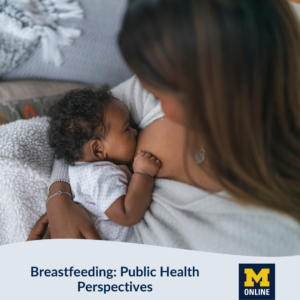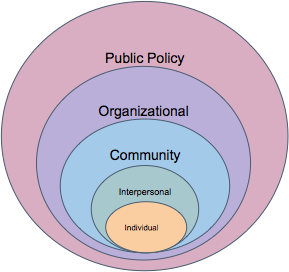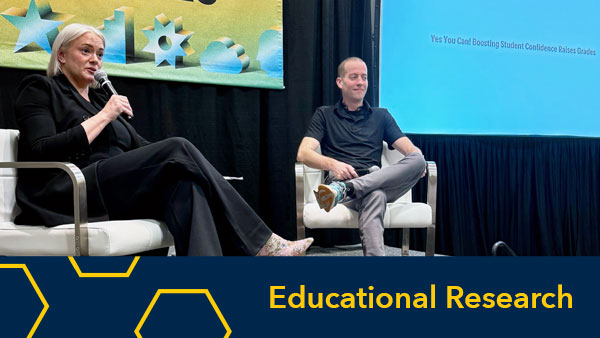The new Breastfeeding: Public Health Perspectives MOOC helps learners develop knowledge and skills to advocate for successful breastfeeding
Olivia S. Anderson, Clinical Assistant Professor, Nutrition Sciences, School of Public Health
 Breastfeeding is the gold standard for nourishing a child and allowing them to thrive. It is unique from formula because it contains all the appropriate nutrients for a child plus bioactive factors that protect the child from disease. There are documented health impacts, both short- and long-term, for the child and the breastfeeding parent(1). Why then, do parents face so many barriers to breastfeeding their child for the period recommended by the World Health Organization(2)?
Breastfeeding is the gold standard for nourishing a child and allowing them to thrive. It is unique from formula because it contains all the appropriate nutrients for a child plus bioactive factors that protect the child from disease. There are documented health impacts, both short- and long-term, for the child and the breastfeeding parent(1). Why then, do parents face so many barriers to breastfeeding their child for the period recommended by the World Health Organization(2)?
- Exclusive breastfeeding for first 6 months of life
- Continued breastfeeding after 6 months with appropriate complementary foods
- Continued breastfeeding for at least 2 years, if it’s mutually desired by parent and child
Breastfeeding – A Public Health Issue
We must consider breastfeeding as a public health issue – meaning that by not breastfeeding according to the WHO recommendations we compromise population health. Further, health is not the only compromise, breastfeeding has environmental and economic impacts.3 There are clear barriers that health professionals, educators, policymakers, employers, and breastfeeding parents can target to support successful breastfeeding across diverse populations.
Public Health Perspectives of Breastfeeding Course
We developed the Breastfeeding: Public Health Perspectives MOOC as an opportunity for various learners to think critically about WHY breastfeeding rates across the globe continue to be sub-par and also consider the direct and indirect effects that sub-par rates have on various populations.
Enroll Now: Breastfeeding: Public Health Perspectives
The framework of the course allows learners to think about interrelationships of breastfeeding barriers across the Socio-ecological Model (Figure). The model orients the learner to identify factors that support or prevent breastfeeding at the following levels:
-

Figure: Adaptation of five levels of the Socio-ecological Model personal (e.g., breastfeeding parent’s confidence to breastfeed),
- interpersonal (e.g., partner’s support to breastfeed),
- community (e.g., lactation support programs),
- organizational (e.g., availability of lactation consultants at a hospital), and
- public policy (e.g., federal policies on maternity paid time off)
Breastfeeding Advocacy
The Breastfeeding: Public Health Perspectives MOOC is a gateway to comprehend the systemic and global issues that contribute to disparities in breastfeeding and equips learners with essential skills to address one or more of those disparities.
The course explores the challenges breastfeeding parents face regarding perceived norms, self-efficacy, and outlines support available from health care providers and employers including from the hospital, outpatient services, clinical lactation experts, maternity leave, and more.
The course also covers important tools and research related to monitoring tools, donor milk banking, support in a child care setting and considerations for the LGBTQ+ community.
Understanding how breastfeeding is a public health issue raises awareness across health professionals, public health practitioners, and the lay public. Breastfeeding is something that all breastfeeding parents should be able to do – we hope this course moves breastfeeding to be an experience that is equitable across all populations, and helps people understand the policies and resources available to help them.
Sources
- Victora, Cesar G., et al. “Breastfeeding in the 21st century: epidemiology, mechanisms, and lifelong effect.” The Lancet 387.10017 (2016): 475-490.
- https://www.who.int/health-topics/breastfeeding#tab=tab_2
- Rollins, N. C., Bhandari, N., Hajeebhoy, N., Horton, S., Lutter, C. K., Martines, J. C., Piwoz, E. G., Richter, L. M., & Victora, C. G. (2016). Why invest, and what it will take to improve breastfeeding practices? The Lancet, 387(10017), 491–504. https://doi.org/10.1016/S0140-6736(15)01044-2



